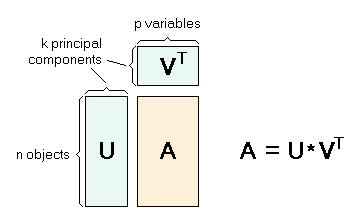| Fundamentals of Statistics contains material of various lectures and courses of H. Lohninger on statistics, data analysis and chemometrics......click here for more. |

|

Home  Multivariate Data Multivariate Data  Modeling Modeling  PCA PCA  PCA - Loadings and Scores PCA - Loadings and Scores |
|
| See also: PCA | |
PCA - Loadings and ScoresIf we look at PCA more formally, it turns out that the PCA is based on a decomposition of the data matrix X into two matrices V and U:   There are a few common plots which are always used in connection with PCA:
The following interactive example shows all of these plots for a data set originating from genuine and forged banknotes.
The word "score" has its roots in old Skandinavian languages. An explanation has been given by W. Clements in the Globe Review, Oct-21, 1999: "Score" rose from the Old Norse "skor2, meaning notch, and "skera" meaning to cut or shear -- an origin it shares with "shard" and "share" (from the notion of divvying something up). It entered the English language in the 14th century as a verb meaning to "notch with lines" and a noun meaning "twenty" -- a use familiar from the Bible's "threescore and ten" (that is 70) and Abraham Lincoln's "fourscore and seven years ago" (that is 87). What did 20 have to do with cutting? The best available guess is that 20 was a standard reference mark when putting notches in a stick (known as a tally) to keep track of debts owed. |
|
Home  Multivariate Data Multivariate Data  Modeling Modeling  PCA PCA  PCA - Loadings and Scores PCA - Loadings and Scores |
|

